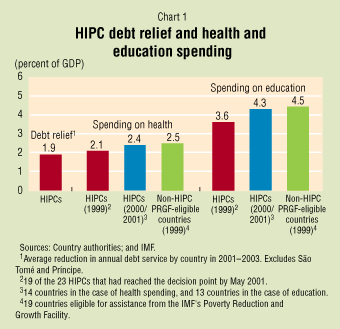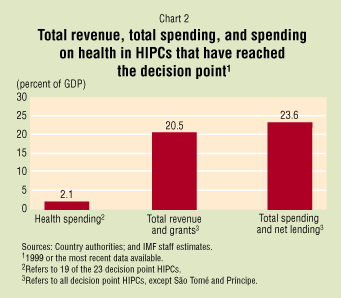 About F&D Subscribe Back Issues Write Us Copyright Information |
Debt Relief and Public Health Spending in Heavily Indebted Poor Countries Sanjeev Gupta, Benedict Clements, Maria Teresa Guin-Siu, and Luc Leruth
The Heavily Indebted Poor Countries (HIPC) Initiative, launched in 1996, was the first comprehensive effort by the international community to reduce the external debt of the world's poorest countries. It went beyond earlier debt-relief initiatives in that it included debt from multilateral creditors like the IMF and the World Bank and placed debt relief within an overall framework of poverty reduction. Enhancements made to this Initiative in 1999 further strengthened the links between debt relief, poverty reduction, and social policies. The underlying objective of the enhanced Initiative is to channel the government resources freed up because of debt relief into poverty reduction programs. Under the programs being negotiated by the World Bank and the IMF with countries eligible for debt relief, government spending on public services—such as preventive health care and primary education—that directly affect the poor will increase. By the end of May 2001, debt relief was committed to 23 of 41 eligible countries: Benin, Bolivia, Burkina Faso, Cameroon, Chad, The Gambia, Guinea, Guinea-Bissau, Guyana, Honduras, Madagascar, Malawi, Mali, Mauritania, Mozambique, Nicaragua, Niger, Rwanda, São Tomé and Príncipe, Senegal, Tanzania, Uganda, and Zambia. At this stage—called the "decision point"—interim debt relief becomes available to these 23 HIPCs, provided they meet certain conditions. This interim relief is provided by the IMF and the World Bank, and by other creditors at their discretion. At the completion point—which countries reach after establishing a track record of policy implementation determined at the decision point—all creditors provide the remainder of their agreed debt relief. Decrease in debt service Countries receiving debt relief under the enhanced HIPC Initiative should see their debt-service payments drop, on average, by 1.9 percentage points of GDP a year during 2001-2003, relative to what they paid during 1998-99 (Chart 1). Based on an average weighted by each country's GDP, debt-service payments will decline by 1.6 percentage points of GDP. Savings on debt service could be quite significant for some countries—for example, Guyana's savings from debt relief will average 9 percent of GDP a year over the next few years.
 Some HIPC debt relief may not be reflected in the beneficiary countries' budgets immediately, however. For instance, relief on debt owed to the IMF may not show up in a country's fiscal accounts initially because it accrues to the central bank rather than to the budget (except in the CFA franc zone countries). Hence, countries may need to set up special accounts in the central bank to identify savings stemming from HIPC relief so that they can be transferred to the budget as grants. Similarly, some public enterprises may benefit from debt relief in the form of write-downs of their government-guaranteed debt, but such write-downs will not be reflected in the government budget unless the savings they entail are transferred to it. Poverty reduction measures The use of funds saved because of debt relief is to be guided by each country's poverty reduction strategy (PRS), which is delineated in a poverty reduction strategy paper (PRSP). The PRSP will determine the basis for access to concessional loans from the IMF and the World Bank. Countries will formulate their poverty reduction strategies in collaboration with the IMF and the World Bank, as well as with civil society and development partners. Updated annually, the PRSP describes a country's plan for macroeconomic, structural, and social policies for three-year adjustment programs designed to foster growth and reduce poverty. Strategies are results-oriented so as to encourage countries to adopt policies that will lead to tangible and measurable improvements in the well-being of the poor. To date, five HIPCs have prepared full-fledged PRSPs; the others have articulated their strategies in interim PRSPs. The PRSPs of the 23 HIPCs that have reached the decision point all include measures designed to increase the poor's access to primary and preventive health care and to primary education. Some PRSPs also call for increased spending on water and sanitation (9 countries), roads and road maintenance (7 countries), and rural development (8 countries), and some include programs that provide housing for the poor and measures to strengthen social safety nets. The funds freed up by debt relief under the enhanced HIPC Initiative will be substantial relative to current and past spending on health care and education. The 1.9 percentage points of GDP released every year are equivalent, on average, to roughly 50 percent and 90 percent of public spending in 1999 on education and health care, respectively, in HIPCs that have reached the decision point. In fact, spending on poverty reduction programs—including for health care—could increase by even more than the resources freed by the enhanced HIPC Initiative. For the 23 countries that have reached the decision point, total public spending and total revenues (including grants) are estimated at 24 percent of GDP and 21 percent of GDP, respectively, while public health spending is estimated at 2.1 percent of GDP in 1999 (Chart 2). By tilting the composition of public spending in favor of poverty reduction programs, the PRSP process could increase the budgetary allocations for these programs.
 There is ample scope to raise spending on health care in HIPCs. Although HIPCs that have reached the decision point have increased their public health care outlays sharply in real per capita terms since the mid-1980s (Chart 3), they still spend less on health care than other low-income countries. In 1999, for example, non-HIPC countries eligible for debt relief from the IMF's Poverty Reduction and Growth Facility spent about 1/2 of 1 percentage point of GDP more on health care than HIPCs that have reached the decision point. In terms of total government outlays, only about 9 percent of spending in the heavily indebted poor countries—ranging from $3 a person in Madagascar to $35 a person in Bolivia and Guyana—was devoted to health care in 1999.
 In light of the urgent health needs of many HIPCs and the challenges posed by HIV/AIDS, it is tempting to argue that all HIPC relief should be channeled to higher public spending on health. In fact, some—including Jubilee 2000, in a joint statement issued in May 2000 by Jeffrey Sachs and Ann Pettifor—have advocated sequestering the external debt service currently being paid by HIPCs in a special fund designed to address these needs. However, even if improvements in health indicators are the most important objective of government policy, it may not be advisable to spend all of the savings from HIPC debt relief on public health. Other government spending programs—such as those for water and sanitation, nutrition, and education for women of child-bearing age—might yield a larger payoff in terms of improving the health of the poor. Furthermore, an exclusive focus on raising health outlays in HIPCs to improve health indicators is not justified. While health indicators have, on average, improved in HIPCs since the mid-1980s (Chart 3)—although from low levels—higher public outlays on health have not always been associated with better performance on social indicators. This has reflected, in part, inefficiencies in this spending and the allocation of health outlays to activities that have relatively little effect on social indicators and the well-being of the poor, such as curative services. Benefit incidence studies confirm that the poor reap a disproportionately small share of the benefits from public health outlays in HIPCs (Chart 4). As such, a comprehensive strategy to improve health outcomes must focus not only on securing additional resources for public health but also on wringing out these inefficiencies in spending and reallocating funds to programs that are most beneficial to the poor. Examples of such programs are those that provide women with prenatal care and vaccinate children against preventable diseases.
 Mindful of these considerations, many countries have focused their PRSPs on steps to improve the efficiency of social spending (including health) and reallocate expenditures to pro-poor activities within each sector. PRSs have generally aimed to improve the quality and extend the coverage of public health services, with an emphasis on disease prevention (see box). To achieve these objectives, HIPCs are committed to increasing public outlays on health programs. However, in line with the considerations described above, resources freed by debt relief will be allocated to a wide spectrum of poverty reduction programs, and health sector outlays are expected to increase by an average of 0.4 percentage point of GDP between 1999 and 2000/2001—less than the total amount of HIPC debt relief.
Beyond the challenge of improving the allocation and efficiency of social spending, HIPCs must overcome a number of additional obstacles if they are to achieve their goals for poverty reduction. Economic growth—one of the key ingredients for poverty alleviation—must be raised well above its historical average in many countries, and capacity constraints in the social sectors must also be tackled if large increases in the provision of social services are to be realized over the next few years. Monitoring use of HIPC debt relief It is critical that debt relief result in an increase in public spending related to poverty reduction programs and that these funds be used for their intended purposes and reach the poor. In this context, all spending on poverty reduction needs to be tracked, not just that associated with the Initiative. The objectives are increases in spending on poverty reduction programs and in the share of total public spending devoted to these programs. This tracking will require the identification of spending on poverty reduction in the context of each country's poverty reduction strategy. In the short run, the analysis of the shift in spending toward more pro-poor programs will have to focus on broad-brush estimates of central government spending by function (for example, education and health care). However, within a given category—health, for example—these estimates will not distinguish between spending directed to helping the poor and other spending (say, hospital care in urban areas). Countries are therefore being encouraged to provide more detailed data. As these become available with improvements in budget classification, it will be easier for countries to track spending on basic social services for the poor (such as primary education and preventive health care). Tracking of spending on poverty reduction programs will require improvements in public expenditure management (PEM) systems and a scaled-up program of technical assistance from international institutions and donors. In the short run, these improvements will involve pragmatic steps to bolster the identification and reporting of spending on poverty-reducing programs, based on existing PEM systems. Over the medium term, more comprehensive improvements that address budget formulation, execution, and reporting will be needed. The ultimate aim of tracking expenditures on poverty reduction programs is to evaluate whether they actually benefit the poor. Simply allocating additional spending to these programs will not suffice to bring about the desired reduction in poverty. Therefore, countries should also monitor the actual delivery and impact of poverty reduction programs. In this regard, monitoring the benefit incidence of health programs and conducting periodic surveys to assess whether funds in the budget actually reach their intended uses could be helpful. Assessing the effectiveness of these programs would also be facilitated by countries' improving their data on social indicators. Such data are produced infrequently, making it difficult to assess the impact of spending. Fewer than half of the PRSPs for countries that have reached the decision point provide data on four or more of the six health indicators (infant, child, and maternal mortality rates; percentage of births attended by skilled personnel; contraceptive prevalence rate; and HIV prevalence in pregnant women 15 to 24 years old) used by the international institutions to monitor the developmental progress of poor countries (see A Better World for All: Progress Towards the International Development Goals, a report published by the IMF, the Organization for Economic Cooperation and Development (OECD), the United Nations, and the World Bank). In their PRSPs, more than half the 23 HIPCs acknowledge constraints that prevent them from monitoring social indicators with any degree of accuracy and note that more work is needed in this area. More timely and complete data will be instrumental in strengthening poverty reduction strategies as countries obtain feedback more rapidly on trends in social indicators and on the impact of programs on these indicators. In addition to obtaining reliable, detailed data, the HIPCs will need to add to the resources made available to them under the enhanced HIPC Initiative by mobilizing domestic resources to assure themselves of adequate funding over the long term for poverty reduction programs. They will thus need to strengthen governance and tax administration—while developing institutions better able to monitor government spending—to achieve sustained improvements in living standards for their poorest citizens. They will also need to craft poverty reduction strategies that are conducive to high economic growth, which will be necessary to ensure that the burden of external debt, relative to the size of the economy, remains sustainable.
For more details on the HIPC Initiative, see http://www.imf.org/external/np/exr/facts/hipc.htm, and on Poverty Reduction Strategy Papers (PRSPs), http://www.imf.org/external/np/prsp/2001/042001.htm. For more information on international development goals, see Shaping the 21st Century: The Contribution of Development Cooperation, a report published by the Organization for Economic Cooperation and Development in 1996. In 2000, the IMF, the OECD, the United Nations, and the World Bank jointly published A Better World for All: Progress Towards the International Development Goals.
|